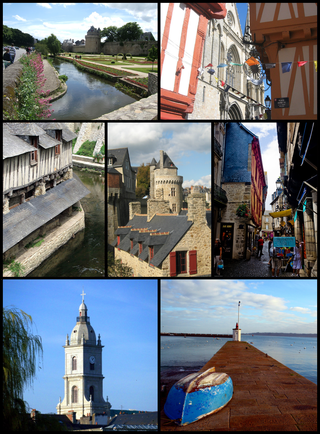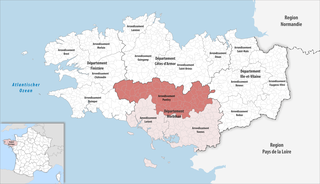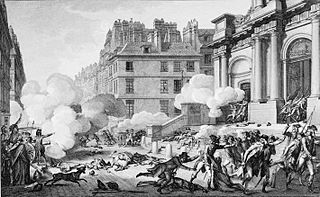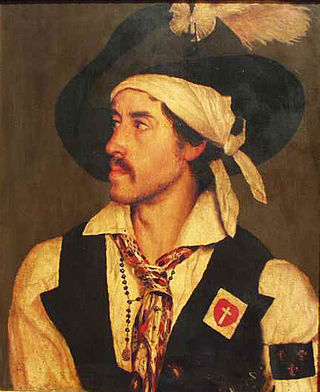
Georges Cadoudal, sometimes called simply Georges, was a Breton politician, and leader of the Chouannerie during the French Revolution. He was posthumously named a Marshal of France in 1814 by the reinstated Bourbons. Cadoudal means in Breton language "warrior returning from the fight".

Vannes is a commune in the Morbihan department in Brittany in north-western France. It was founded over 2,000 years ago.

Auray is a commune in the Morbihan department, administrative region of Brittany, northwestern France.

The Chouannerie was a royalist uprising or counter-revolution in twelve of the western départements of France, particularly in the provinces of Brittany and Maine, against the First Republic during the French Revolution. It played out in three phases and lasted from spring 1794 to 1800.

Île-d'Arz is an archipelago of nine islands and a commune in the Morbihan department, Brittany, northwestern France, only 6 kilometres to the southwest of Vannes.

The arrondissement of Pontivy is an arrondissement of France in the Morbihan department in the Brittany region. It has 92 communes. Its population is 155,521 (2016), and its area is 2,944.6 km2 (1,136.9 sq mi).

13 Vendémiaire, Year 4 in the French Republican Calendar, is the name given to a battle between the French Revolutionary troops and Royalist forces in the streets of Paris. This battle was part of the establishing of a new form of government, the Directory, and it was a major factor in the rapid advancement of Republican General Napoleon Bonaparte's career.

Jean Chouan was the nom de guerre of the Frenchman, Jean Cottereau, who was born in Saint-Berthevin, near Laval, in the department of Mayenne on 30 October 1757 and died 18 July 1794 in Olivet, Mayenne. He was a counter-revolutionary, an insurrectionist and a staunch royalist.

Bignan is a commune in the Morbihan department in Brittany in northwestern France.

Plumelec is a commune in the Morbihan department of the Brittany region, in north-western France.
The Catholic and Royal Armies is the name given to the royalist armies in western France composed of insurgents during the war in the Vendée and the Chouannerie, who opposed the French revolution.

The Army of the Alps was one of the French Revolutionary armies. It existed from 1792–1797 and from July to August 1799, and the name was also used on and off until 1939 for France's army on its border with Italy.

The Invasion of France in 1795 or the Battle of Quiberon was a major landing on the Quiberon peninsula by émigré, counter-revolutionary troops in support of the Chouannerie and Vendée Revolt, beginning on 23 June and finally definitively repulsed on 21 July. It aimed to raise the whole of western France in revolt, bring an end to the French Revolution and restore the French monarchy. The invasion failed; it had a major negative impact, dealing a disastrous blow to the royalist cause.

The Battle of Savenay took place on 23 December 1793, and marks the end of the Virée de Galerne operational phase of the first war in the Vendée after the French Revolution. A Republican force of approximately 18,000 decisively defeated the Armée Catholique et Royale force of 6,000 at Savenay.

Jean Victor Tharreau or Jean Victor Thareau, was a General of Division in the Army of the French Empire.

Marie Pierre Louis de Frotté was a French soldier and an opponent of the Republic during the Revolutionary Wars.
Olivier Delourme (1660–1729), nicknamed "the architect of Brittany", was a French architect of the "Grand Siècle" renowned for his many achievements still existing, mainly in Morbihan.

The Battle of the Tombettes took place in 1800, between the Chouans and the Republicans during the Chouannerie.
Henri-Louis de Boulainvilliers de Croy was a French Navy officer. He served in the War of American Independence. He was a member of the Society of the Cincinnati.
Jean-Baptiste de Moriès de Castellet was a French Navy officer. He served in the War of American Independence. He was a member of the Society of the Cincinnati.
















